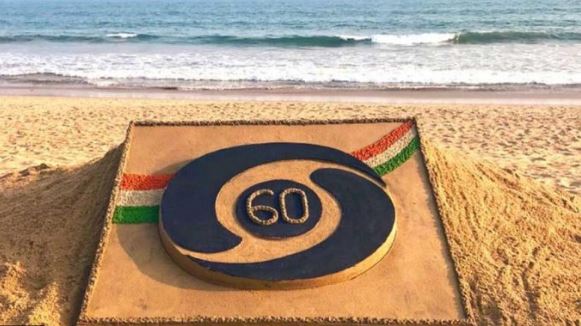Mumbai: Edged in grainy black and white and blurry colours with a rough-cut feel, they were the wonder years of television when content was king — and queen — with themes ranging from societal divisions and gender struggles to office intrigue and stories from history and literature.
As Doordarshan turned 60 this month, it was time to unspool memories of an era gone by when television took on the challenge of making audiences introspect, laugh out loud and get informed, without FX, zoom-in, zoom-outs and other stratagems that come with technology.
“Doordarshan had its heart in the right place,” said veteran actor Farida Jalal, who starred in “Yeh Jo Hai Zindagi”, a fun show about a madcap family.
That was when there was just one channel, black and white till the early 1980s when colour television first made its advent, and entire families gathered around the screen to watch a televised stage play, a film every Sunday evening and catch up on their favourite serials, rationed at one episode a week.
The government-run channel may have lost its magic along the way but no amount of time spent on Netflix or Hotstar can replace the nostalgia for “Buniyaad”, a lavish Partition saga, “Udaan”, about a young woman’s struggle to become a police officer, “The Jungle Book”, an animated Hindi version of the Rudyard Kipling classic, “Fauji”, which saw Shah Rukh Khan make his debut, and, of course, “Mahabharat” and “Ramayana”.
There was also Bhisham Sahni’s “Tamas”, adapted for television by Govind Nihalani, R K Narayan’s “Malgudi Days” that brought to life the small fictional town of Malgudi, and “Bharat Ek Khoj”, Shyam Benegal’s 53-episode show based on Jawaharlal Nehru’s “The Discovery of India”.
People timed their work according to show schedules, children were encouraged to complete their homework with a bribe of watching their favourite show, and at a time when not every home had a television, neighbours made sure to keep their doors open.
Doordarshan shows were better and more progressive and Bollywood a poor cousin, said Renuka Shahane, who co-hosted “Surabhi”, a cultural magazine of sorts on television, with Sidharth Kak.
“I’ve seen the changing world of TV over the decades. I think we were really blessed to be a part of that wave. The content was very good. More than fame and name, it was about the kinds of things we got to do.
“It hadn’t yet become a bureaucratic thing. It was still a creative space in the beginning. Because it was in a nascent stage, the government wanted to rope in the best. The best of filmmakers made their mark on TV at that time and left behind a legacy of really good work. Cinema of those times was a very poor cousin of TV,” Shahane told PTI.
The multiplicity of private channels, the enormous increase in resources and the high viewership have done little to forward the cause of meaningful content. In fact, in their attempt to appeal to everyone, what passes as entertainment is facile, unrealistic and often regressive, said several industry insiders.
Expressing sadness at the state of affairs of Indian television today, Jalal said the progressive, innovative spirit of the era has been lost.
“I wish those days could return. They made best of the shows such as ‘Yeh Jo Hai Zindagi’ and ‘Khandaan’. These shows meant or said something. Today, it is about ‘naagin’, ‘jaadu-mantras’ and frivolous things… there is no depth,” said Jalal.
Seema Pahwa, known to Bollywood viewers as the lovable mother of “Bareilly Ki Barfi”, cut her acting teeth as ‘Badki’ on “Hum Log”, one of Indian television’s longest running daily soaps.
Written by eminent Hindi writer Manohar Shyam Joshi, the show depicted the everyday travails of a middle class family.
For Pahwa, it was the best era for stories, something that no private channel or streaming service can replicate.
“It was the best era and still is in terms of stories… I remember when I started ‘Hum Log’, it was local but then became a national level show,” Pahwa told PTI.
Actor Supriya Pilgaonkar, who started as the host of a children’s programme in Marathi, went on to be a part “Ek Kahani”, an episodic show on stories from Indian literature, and “Tu Tu Main Main’.
“Till date, I’m remembered for these Doordarshan shows and I feel extremely nostalgic whenever I sit and think about it,” she told PTI.
Mandira Bedi and Amit Behl, who found fame at a young age with “Shanti”, about a woman journalist looking to unravel the truth behind her birth, said the kind of viewership the show had cannot be captured today.
“I had a great run on Doordarshan. My life changed completely,” Bedi said.
Behl, her co star, said it was disheartening to see the drop in quality due to budget cuts.
“The national broadcaster needs to pull up its socks in a way that it again becomes a force to reckon with. DD needs to revamp its programming. ‘Shanti’ was a show way ahead of its time, contemporary and rich,” he added.
According to actor Anup Soni, the best talent veered towards Doordarshan.
“Fifty per cent of the shows were dependent on literature, classic writers. They were adapting novels from different writers. The original content they were making was very close to a common man’s life. From ‘Hum Log’ and ‘Buniyaad’ to ‘Udaan’, people could relate to these shows, which were so progressive and inspiring,” he said.
Doordarshan began as an experiment on September 15, 1959 and became a service in 1965, when beamed signals to reach television sets in living rooms in and around the national capital.





